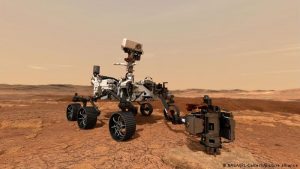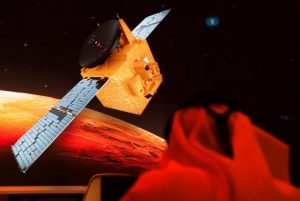09-02-2021
DUBAI: The Red Planet is about to get a little crowded. Three separate missions to Mars launched by the United States, China and the United Arab Emirates (UAE) will all reach their destination this month after taking flight within just 11 days of each other in 2020.
 The un-crewed missions promise to yield new insights for Earth-bound scientists intent on unraveling the mysteries of the solar system and scanning Mars for signs of extraterrestrial life, as well as enhancing our collective understanding of the cosmos but the Mars ventures are also the latest landmark in the new geopolitical space race, say experts, as the world’s most powerful nations once again compete with one another for dominance beyond Earth’s surface.
The un-crewed missions promise to yield new insights for Earth-bound scientists intent on unraveling the mysteries of the solar system and scanning Mars for signs of extraterrestrial life, as well as enhancing our collective understanding of the cosmos but the Mars ventures are also the latest landmark in the new geopolitical space race, say experts, as the world’s most powerful nations once again compete with one another for dominance beyond Earth’s surface.
“Competition in space is heating up,” Christopher Impey, a professor of astronomy and associate dean in the College of Science at the United-States based University of Arizona, told media. “Three missions arriving at Mars in one month is unprecedented.”
“Collectively, they will add a lot to our knowledge of the Red Planet,” Impey added.
Each of the ventures has “different aims and capabilities”, Impey said. The US and Chinese missions, which come against the backdrop of an intensifying geopolitical rivalry between the two nations, include plans to land exploratory rovers on Mars, while the UAE is focused on surveying it from above via an orbiter.
 The UAE’s mission will be the first to arrive in Mars’s orbit on Tuesday, ushering in a new era of space exploration for the Gulf nation.
The UAE’s mission will be the first to arrive in Mars’s orbit on Tuesday, ushering in a new era of space exploration for the Gulf nation.
The UAE’s great space ‘hope’
Named Al Amal, the Arabic word for “hope”, the UAE Space Agency’s probe represents its first foray into space.
Al Amal will spend 687 days, a period equivalent to one year on Mars gathering information on the Martian atmosphere and surveying the planet’s weather patterns throughout its four seasons.
In doing so, it may shed light on the mystery of Mars’s transformation from a warm, wet world one with an atmosphere thick enough to support liquid water on its surface, and potentially capable of supporting life into the cold and barren planet it is today.
Matthew Siegler, a research scientist at the non-profit US-based Planetary  Science Institute, said the probe’s findings could help to determine when conditions conducive to life existed on Mars.
Science Institute, said the probe’s findings could help to determine when conditions conducive to life existed on Mars.
“The Martian atmosphere is presently too thin for liquid water to be stable on the surface,” Siegler told media. “By carefully measuring the atmosphere, we can better model how long ago the atmosphere may have been suitable for liquid water on the surface, and therefore potentially suitable for life.”
As well as promising to improve our understanding of Mars’s past, the craft’s research could also guide scientists’ planning for future missions and enhance their understanding of whether the fourth planet from the sun has the potential to receive human visitors or, in the longer term, settlers, the head of the UAE Mars missions, Omran Sharaf, told National Geographic. (Int’l Monitoring Desk)
 Pressmediaofindia
Pressmediaofindia




